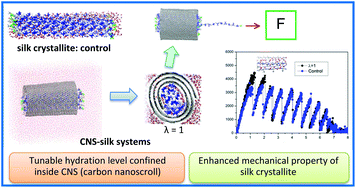Carbon nanoscroll–silk crystallite hybrid structures with controllable hydration and mechanical properties†
Abstract
Hybrid structures of nanomaterials (e.g. tubes, scrolls, threads, cages) and biomaterials (e.g. proteins) hold tremendous potential for applications as drug carriers, biosensors, tissue scaffolds, cancer therapeutic agents, etc. However, in many cases, the interacting forces at the nano–bio interfaces and their roles in controlling the structures and dynamics of nano–bio-hybrid systems are very complicated but poorly understood. In this study, we investigate the structure and mechanical behavior of a protein-based hybrid structure, i.e., a carbon nanoscroll (CNS)–silk crystallite with a hydration level controllable by an interlayer interaction in CNS. Our findings demonstrate that CNS with a reduced core size not only shields the crystallite from a weakening effect of water, but also markedly strengthens the crystallite. Besides water shielding, the enhanced strength arises from an enhanced interaction between the crystallite and CNS due to the enhanced interlayer interaction in CNS. In addition, the interfacial strength for pulling the crystallite out of the CNS–silk structure is found to be dependent on both the interlayer interaction energy in CNS as well as the sequence of protein at the CNS–silk interface. The present study is of significant value in designing drugs or protein delivery vehicles for biomedical applications, and serves as a general guide in designing novel devices based on rolled-up configurations of two-dimensional (2D) materials.



 Please wait while we load your content...
Please wait while we load your content...